
bigb
-
Posts
320 -
Joined
-
Last visited
Content Type
Profiles
Forums
Articles
Gallery
Downloads
Events
Posts posted by bigb
-
-
8 hours ago, ThomasPowers said:
How do you get from Arizona to I 25? I-10, HW 60? ??? I'm about 2 miles off an I-25 exit near Socorro; but can see it from the house as it's the offset frontage road sort of thing... Have you checked out Ruidoso?
We take I-10 to Deming then 26 to Hatch where we get on I-25. Been to Ruidoso a few times....years ago. Just had a friend move up there though so we will no doubt go visit.
-
We come straight up I-25 into Santa Fe or Las Vegas. In July we spent a week in Mora. (Cleveland actually but everyone thinks that is in Ohio). Planning to retire soon and will likely spend summers up there, will be doing a lot of day trips and exploring then.
-
I have thought about that but it's getting to the point where I need to be done setting up my shop and actually use it. I am going to rig up a support like Thomas suggested, although not sure about the duct tape
 . Thomas as many times as I have driven through Socorro one of these days I should stop and buy you lunch. Or bring you something from Arizona. Do you need any cactus?
. Thomas as many times as I have driven through Socorro one of these days I should stop and buy you lunch. Or bring you something from Arizona. Do you need any cactus?
-
It's on this 3 legged stainless steel adjustable meat plant scale table that I got for free. I like it because I can set the height so I don't have to bend over to look into the forge. I thought about a support arm, maybe I'll make one coming off the shaft that can rotate out and away from the forge.
Duct tape? hmmmmm... I didn't think of that either. I guess I am not really a duct tape kind of guy

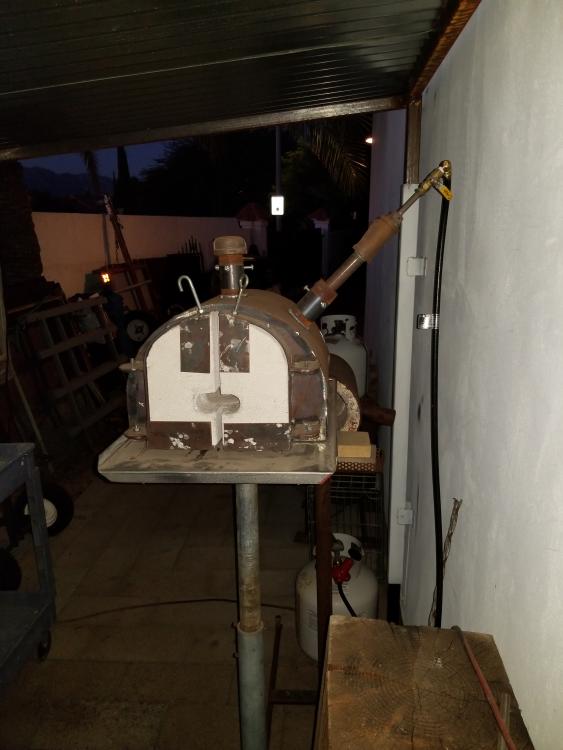
-
I tried using some 3/4 ' flexible metallic conduit today but it is just too heavy, it wants to pull against my burner assembly and I am afraid it will damage the small 1/8" pipe or pull everything off center. I thought about some kind of support but I tend to move the forge around, plus my roof in my work area cranks up and down so that won't work too well. I am going to pick up some aluminum 3/4" flexible conduit, it weighs less than 1/2 what the steel weighs, and try that.
-
There is an open forge here in Tucson tomorrow at Harold Hillborn's shop with a tool making demo by Joe Madrid who believe it or not is a distant cousin of mine that I met through AABA and an accomplished blacksmith. I am going to glean all I can about tool making and treating.
-
It was nice living on a lake growing up but I still have bad memories of cold, snow and ice and trying to deliver 40 copies of the Chicago Daily News in it.
-
Thanks Mark. Are you near Crystal Lake? I lived there till I was 13.
-
It helps a lot. I have not done any sort of heat treating or normalizing yet (with the exception of annealing some copper) but I am going to make a crude attempt at making my leg vise hardware from looking at yours. If it doesn't turn out well I can always try again. Right now it's just functionality for me, the pretty stuff will come later, I hope.
-
Steve,
If you don't mind could you show the tool you used to hot punch the 1X1 stock after drilling?
-
The material you have is the right stuff!!
Neil
Good cause I have plenty of that!
-
Thanks for this post (no pun intended) I need to get busy and make mounting hardware for both of mine. Your detailed post will help a lot. Looking forward to some shop time now that cooler weather is on the way.
One question, why A36? My metallurgy knowledge is very weak.
-
I really like your side draft chimney, it looks just like mine! My coal forge is outdoors so the chimney works great when there is no breeze but I have to add wind breaks when a breeze comes up.
-
I think I will just cut them up in little pieces on the band saw and tack them to a base plate in a circular pattern for a basket/pot. I'll make them uneven for a more interesting look. Keeping them out of the forge will retain the copper finish too, except for the cut ends .Maybe save one for a weather vane pole as Don suggested.
It's been a long, hot summer here and I didn't do any metal working except some sheet metal, finally cooling a bit and I am getting ready to spend some time in the shop. It's still near 100 but I am getting ready.......
-
-
6 hours ago, Marc1 said:
All of the above ... but for the swamp cooler. If the swamp cooler is a portable evaporative air conditioner, that needs to be in an enclosed space with an outdoor vent, hardly ok for a smithy, plus they tend to be small.
javascript:;
It is nothing more than a big fan with a water soaked media, does not need to be in an enclosed space at all. In fact if you close it in too much the humidity will rise. Needs to draw in fresh, outside air and plenty of exhaust. When used on a building it is a constant air changeover, CFM in = CFM out otherwise it will be inefficient and create high humidity in the enclosed space. As far as being small that is why you use one from a house, not the store bought shop models. Mine will give you chills when the outside temps are in the hundreds.
-
I work under a tin roof in the Southwestern Arizona desert. I got a used 4400 CFM side draft swamp cooler and put it up on a stand with casters (free stainless steel rolling stand thrown away by supermarket), put a garden hose hookup on it and a j box with a rotary switch and plug in cord. Hardware cloth over the squirrel cage opening to prevent finger chopping accidents. I can place it just where I need it so it keeps me cool and doesn't blow on the forge. The stand I used is tall enough to keep the breeze on my upper body. Works great and I couldn't work in the summer afternoons without it. There are store bought "shop coolers" but they are expensive and do a poor job IMHO.
-
A chandelier of that size and weight warrants a lift. Once the lift is properly secured to the structure the fixture can be installed, cleaned and serviced easily. Among the more well known makers are Aladdin and Peter Albrecht.
-
I went to get my card at the last minute and I was afraid they'd be out. Then I realized when I got there and the whole card aisle was mostly guys there would be plenty as most of us guys wait till the last minute.
-
Don't know if you did it yet but I put a 8" Chimenea pipe thru a corrugated metal roof almost 20 years ago and it is not leaking yet. I simply got the flashing then used a tube of GE Silicone on the uphill side and pressed it down. Don't try to seal the downhill side or it could trap water in and leak. I've had some roaring fires in that Chimenea over the years and the pipe immediately above it has gotten sizzling hot but the silicone is still holding. The silicone also is rubberized so it gives for expansion instead of cracking like plastic roof cement.
-
9 minutes ago, BIGGUNDOCTOR said:
The reason to with 220 instead of 110 is the amperage draw. 220 will pull one half of the amperage that 110 will. If a 110 kiln pulls 50 amps the same setup in 220 will only pull 25 amps.
for wire sizing and voltage drop loss calcs yes but for total power consumption no, In a resistive load like a heating element Amps X Volts= Watts so end cost is basically the same minus VD losses on the 240 volt circuit. You can't get around Ohms law.
-
heh heh well I am not calling myself a blacksmith just yet! I do however have a friend who is quite accomplished and I will ask him to assist me when he has a little time.
-
I have a terrible time with my tongs. From the fire to the anvil I usually lose a lot of time fumbling around trying to turn the work piece how I need it, sometimes dropping it, losing heat as I fumble around. All my tongs are used flea market bargains except two pair of Wolf jaws. I am thinking of ordering some quick tongs and make them to fit my work better, but mostly right now I think it's just that I haven't practiced enough and my coordination is not that great anyways. I have considered just welding rebar onto my pieces but resisted thus far because if I do that I will never get the hang of the tongs, plus that's a PITA anyways.
-
Finished the forge today and fired it. I didn't time anything but it did get hot pretty quickly and once warmed up it had no trouble heating my test pieces. It's got a real good swirling effect. I noticed the hottest point seems to be the side opposite the wall that the flame rolls into. It seems to roll along the floor, up the wall and across the roof, down the other wall and develops a hot spot right as the tip of the flame hits the floor again. The front 2/3 section seems to get hotter than the back, I might try aiming the burner toward the back a bit. I have the burner recessed about 1.5" past the Kast-O-Lite and into the ceramic blanket liner.
Now I need to study up on making the flame optimal and efficient, and build an idle circuit.
Tried to put in a short video, not sure if it will work
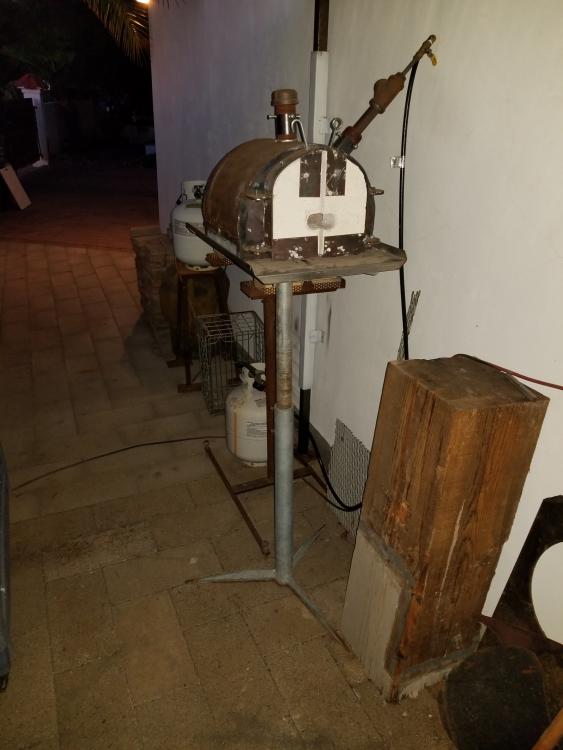
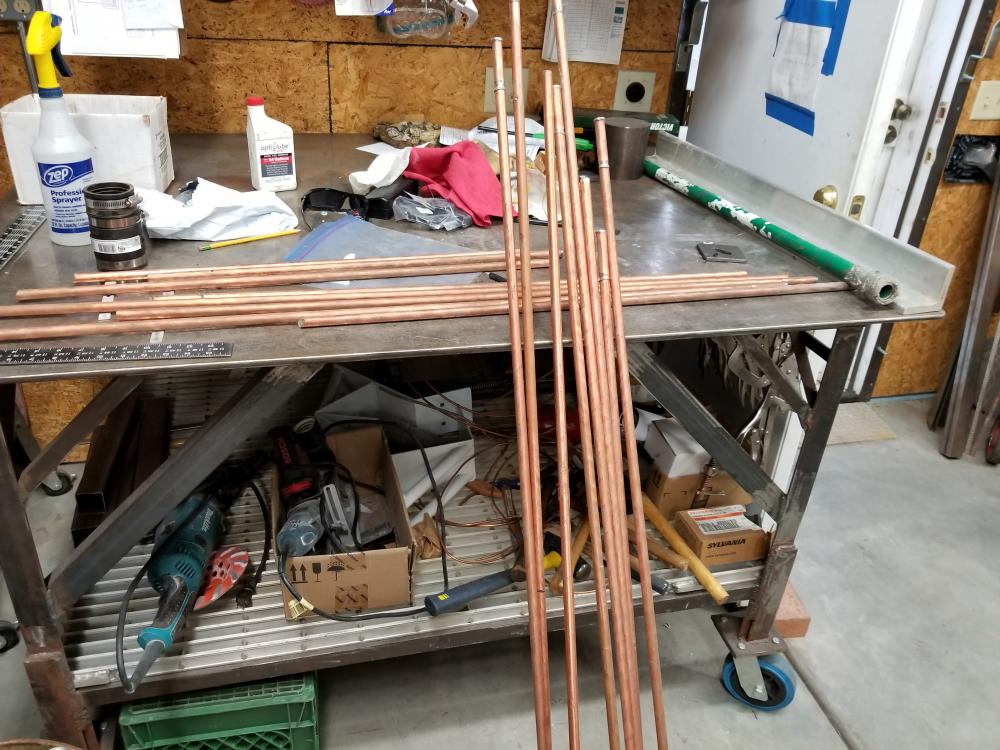
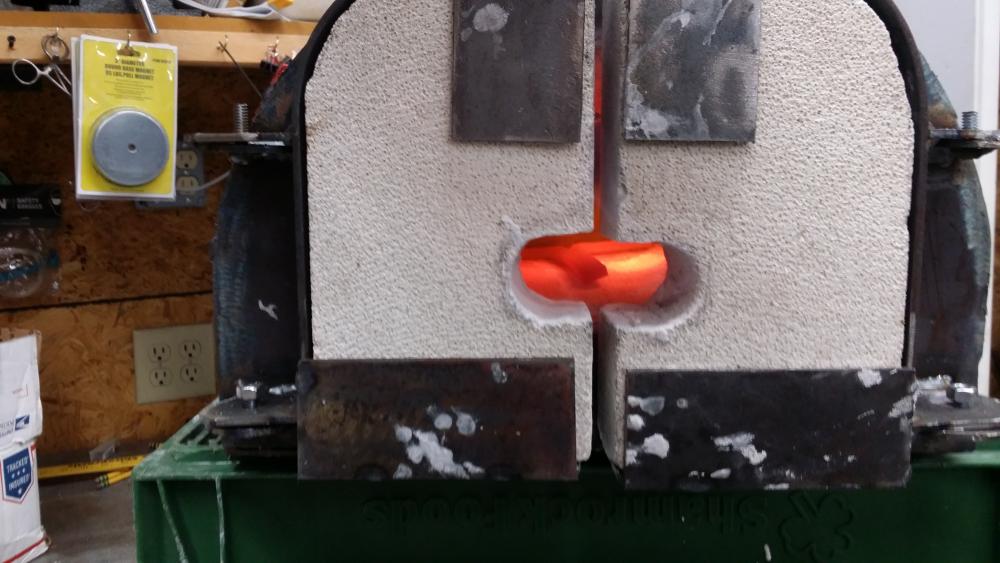
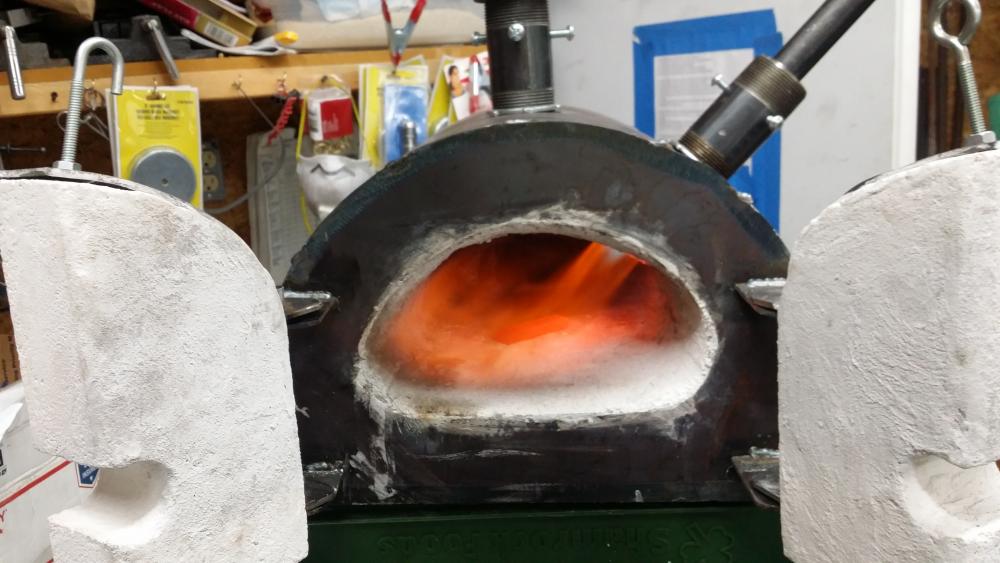
Up and running
in Gas Forges
Posted
I noticed it too, I always have a dozen or more projects going on at the same time in mine. Stuff everywhere.